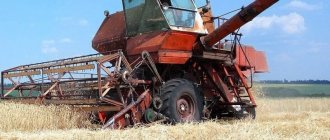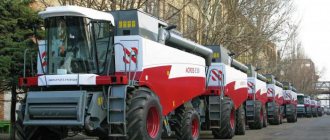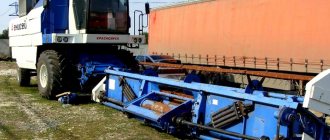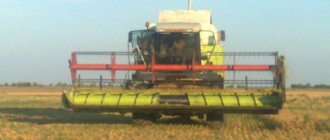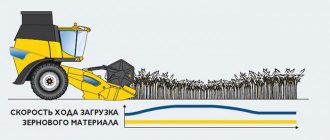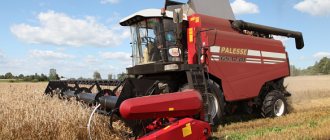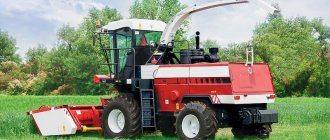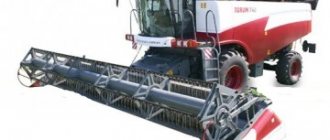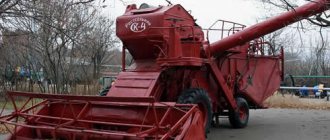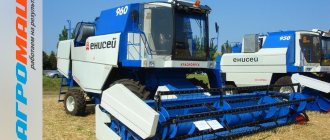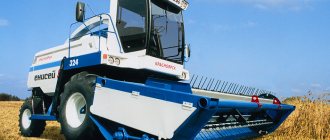Zarya mini-harvesters are small-sized combined machines that allow you to harvest grain from small plantations.
The Zarya brand is traditionally considered Russian, since it was recreated on the basis of developments. Although the entire production cycle is located in China today, the original features of these agricultural machines have been preserved. The basic configuration of the Zarya equipment allows you to combine in one device the functions of cutting the stems of cereals, their milking and separation. With the use of appropriate adapters, they can easily be converted into forage harvesting machines used for harvesting corn, rice and sunflowers.
About the device
As mentioned earlier, mini grain harvesters are practically no different from larger combines, performing absolutely identical work.
Such units collect the ears of corn and then grind them. It often happens that it is not necessary to immediately process what has been collected. In such cases, a grain hammer crusher is used. The final process will be to clean the resulting grain from straw and other debris.
The use of this technology allows you to simultaneously perform several tasks that were previously available only to a certain type of equipment performing each type of activity.
We are talking about a thresher, a winnower and a reaper.
As for modern mini grain harvesters, they can be equipped with additional equipment that can significantly expand their functionality. In particular, with the help of such units it becomes possible, in addition to harvesting grain, to sow vegetable seeds, knit sheaves, etc.
Most models of mini combines are equipped with a seat for the operator, and some are smaller copies of large combines, i.e. their design includes a full-fledged operator cabin.
Movement is carried out using three forward gears (some models may have more gears) and one reverse gear.
There are several levers in the cockpit, each of which is responsible for a specific task.
In particular, there is a clutch lever, a gear shift lever, as well as control levers with which you can adjust the cutting height of the ears. This is a very useful feature, especially in areas with slopes and difficult terrain.
These grain harvesting units have a low-power diesel engine , which allows significant savings on fuel consumption.
This is very important for individuals who have a fairly small subsidiary farm, where large capacities are not required, but the issue of saving is always quite acute.
At the final stage, when straw and other debris are removed, the grain ends up in a special bag or tank (in larger models). As for the straw, it is discharged through a different channel, separate from the cleaned grain material.
Based on this, we can summarize the main advantages of this type of technology:
- Affordable price for a mini harvester, which is acceptable for most categories of citizens.
- Economical fuel consumption, which has a positive effect on the cost of the final product.
- The compact dimensions of the unit allow it to show good maneuverability, which is very useful in areas where there is difficult terrain.
- Ease of operation allows you not to obtain a special permit or appropriate certificate.
- Possibility of carrying out repairs directly on the job site, without transportation to a service center.
- Due to their small dimensions, these mini harvesters can be easily stored in relatively small spaces.
For more information about the operation of the mini-harvester, watch the video:
Features of operating mini-reapers
Even taking into account that such models are small in size, they do an excellent job of cultivating fields with subsequent separation of ears and threshing them. As a result, such units are capable of simultaneously replacing 3 different devices. When installing trailed equipment, they will also knit sheaves of hay. Most models are equipped with classic gearboxes that have 3 gears intended for forward movement, as well as 1 for reverse. They are switched by a special lever. It is also possible to adjust the height at which the ears are cut.
Advantages of mini-harvesters
Based on all of the above, the following advantages of this technique can be identified:
- Ease of transportation of the unit.
- Low cost models.
- Possibility of use for small areas or in the presence of complex terrain, which is ensured by its small size and high maneuverability.
- Low fuel consumption.
- Easy to use mini-harvester.
- There are no complex components, which allows you to carry out repair work while in the field.
Types, technical characteristics and prices
For private owners
A mini grain harvester for a private owner can be called such if its design complies with
certain
parameters and conditions. In particular, the “mini” category includes those units whose header working width does not exceed three meters, unlike trailed grain harvesters.
In most cases, this indicator varies from one to two meters.
Accordingly, the simpler the design of the combine, the lower this indicator, i.e. such models may lack not only a cab, but also a seat for the operator. A header working width of two meters or more is found in mini-harvesters equipped with a seat and a full-fledged closed cabin.
Based on this, a certain classification of this technique can be distinguished:
- small mini harvesters. Such units are controlled by a person walking behind, i.e. they lack basic conditions, such as a seat. The width of the header in such devices rarely exceeds one meter;
- medium mini harvesters. The working width of the header exceeds one meter, and the unit itself is equipped with a seat for the operator;
- large mini combines. Such units are already similar to full-fledged combines; their design includes not only a seat, but also a cabin. The width of the gripper is from 2 to 3 meters. A prominent representative is the Niva combine.
The Russian agricultural market offers a wide variety of mini grain harvesters manufactured not only at domestic factories, but also abroad.
New attachments for Neva walk-behind tractors provide enormous opportunities for Russian farmers.
One of the most popular walk-behind tractors is the Salyut brand. You can read about his additional equipment here.
The largest mining dump truck in the world began to be produced for the first time in the USA. If you follow the link above, you can see his photo.
Chinese
In particular, Chinese units have become widespread, featuring quite good performance indicators, just like mini tractors. In this case, we will consider them in more detail, and also pay attention to some Russian models.
Chinese industry traditionally produces a lot and supplies a lot of different equipment, including agricultural equipment.
The big advantage is that you can order additional options from the manufacturer, thanks to which you can significantly expand the functionality of mini harvesters.
The DongFeng 1548 mini-harvester is fully adapted to the harsh Russian conditions, and is also considered one of the most profitable purchase options in terms of price-quality ratio. Such a unit, which is an almost exact copy of standard combines, can be equipped with additional equipment.
- total weight - 2.175 tons;
- length – 510 cm;
- width – 190 cm;
- height – 240 cm;
- power indicators - 53 hp;
- header working width – 2 meters;
- grain tank capacity – 0.8 m3;
- productivity indicators – up to 5300 m2 per hour.
The concept of creating miniature equipment for farmers
Russia and other CIS countries inherited large agricultural enterprises from the USSR. Even modern farms are trying to model the style of work and the implementation of basic agricultural operations according to the principles developed since the early 30s of the last century.
Real farming does not expect to attract large numbers of people to work. On the contrary, they try to perform the work individually, concentrating several operations in one hand. Therefore, they try to equip agricultural machines with multifunctional mounted trailed units. For example, the John Deere X 700 minitractor has more than 50 mounted and trailed units. Depending on the production tasks, the farmer purchases the necessary equipment and uses it to obtain maximum profit.
Farm area sizes
The size of farm areas in some countries is shown in the table.
| Average farm area in countries, ha | Direction of agricultural activity | |
| Crop production | Livestock | |
| Germany | 180…320 | 15…30 |
| France | 210…430 | 20…40 |
| Spain | 130…260 | 15…25 |
| Italy | 120…220 | 10…20 |
| USA | 520…750 | 60…90 |
| Australia | 1000…3000 | 250…450 |
| Japan | 45…70 | 5…12 |
It turns out that not much land is concentrated in the hands of one user. It can be serviced without the involvement of powerful and highly productive agricultural machines. There are not many millionaires among farmers around the world, although their fortune is estimated at several million dollars, they can really only be obtained by selling their land and equipment. But it is these farmers who produce the main agricultural products that feed the population.
Energy saturation of agricultural production
The energy intensity of farming is one of the most important indicators of production. Energy saturation refers to the specific power per 1 hectare of arable land. As a result of the analysis of indicators, a table was compiled.
| Average energy intensity of one hectare of arable land in countries, kW/ha | Direction of agricultural activity | |
| Crop production | Livestock | |
| Germany | 3,5…4,8 | 12,0…18,5 |
| France | 2,4…3,8 | 8,4…9,0 |
| Spain | 0,8…1,9 | 5,2…6,0 |
| Italy | 0,7…2,2 | 4,8…5,5 |
| USA | 7,5…8,8 | 12,8…20,5 |
| Australia | 0,6…1,5 | 3,2…4,0 |
| Japan | 8,5…10,0 | 15,5…18,8 |
The higher energy saturation in livestock farming is explained simply; they use machines to prepare feed for feeding; they use not only roughage grinders, but also devices for producing hot water and steam.
The warmer the climate in a particular country, the less power is required to service the available area. The intensity of work is also lower; the lack of energy from tractors and agricultural machinery is compensated by the excess solar energy per hectare.
Basic requirements for small-sized agricultural machinery for grain harvesting
Based on the observations outlined above, the basic requirements have been formulated that it is advisable to take into account when choosing equipment for small areas of grain crops:
- low cost of cars. Everyone understands that expensive equipment will require large loan payments, eating up all the profit received;
- low specific fuel consumption per unit area. The lower the fuel consumption, the higher the labor efficiency, since the cost of purchasing fuel is reduced;
- small overall dimensions will allow you to leave smaller turning lanes, which saves crop area;
- simplicity of design. It is known that modern farmers do many jobs with their own hands and save on everything.;
- simple operating techniques will allow you to independently operate agricultural machines and not involve additional hired workers with high qualifications;
- Convenient transportation and compactness will reduce the cost of delivering equipment to hangars for storage during the winter. There are few requirements. The main thing is to make the equipment as miniature as possible.
The principle that the miser pays twice works most noticeably here. Some try to purchase equipment with a reserve of power and other indicators. As a result, they are forced to incur additional costs for maintaining the purchased equipment.
Subscribe to the Facebook group and stay up to date with the latest news on gardening and vegetable gardening!
How to make a mini grain harvester with your own hands - assembling a homemade device
In principle, a homemade mini grain harvester can be made on the basis of any tractor, for example, the T-40. U
These units have all the necessary components that are necessary for the full operation of the combine, i.e. sufficiently powerful engine, wheelbase, driver's seat, etc.
Due to the fact that grain harvesting is carried out in the summer, the tractor cabin can be removed for greater driver comfort.
The main essence of the modification is to add a header to the tractor structure. You can take KPKU-75, whose working width is approximately three meters, or use another one. The Internet is full of advertisements for the sale of such components, so there should be no problems finding them.
For better balancing, you need to provide some kind of counterweight (water tank or gas cylinders) behind the tractor. As a tractor, you can easily use the Terrion, Challenger, New Holland or MTZ 80 model. We wrote about the latter in detail in this article.
Design and principle of operation of the TOP 5 mini-harvesters for grain harvesting
A mini-harvester for grain harvesting is an agricultural equipment that is used in small farms and collective farms. The unit has high power, despite its compact size, and easily performs the assigned tasks of collecting, threshing, cleaning grain and sifting it from debris and impurities. During operation, the tractor does not damage the soil structure and does not harm the crop.
History of the production of combine harvesters
If we go back to history, we would like to draw attention to the fact that at the beginning of the twentieth century, more than 50% of the total labor costs accounted for labor in the field of agricultural production.
Agricultural workers had to manually do what powerful machines do today: mowing crops, threshing and sifting grain. Since the first means of mechanization of agricultural production appeared, a real revolutionary breakthrough has occurred in this area. As technological progress progressed, agricultural machinery, including grain harvesting combines, improved, and the share of manual labor decreased significantly. Today in some economically developed countries the share of manual labor is no more than 2%.
Design and principle of operation
The design of a mini grain harvester includes:
- cutting apparatus;
- reel;
- screw;
- feeder;
- threshing and separating unit;
- receiving beater;
- shaking board;
- straw walker;
- chopper
The reel, rotating, tilts the dead grain, which is picked up by the cutting blades and mowed. The stem structure sequentially enters the auger mechanism and the inclined chamber. The receiving beater moves the cut mass into the crushing drum with installed whips, which hit the ears. As a result of the impacts, the grain is separated and comes out through the deck cells. The whips have the correct design, so the seeds are not deformed and are threshed up to 80%.
The remainder of the unprocessed mass goes to the keys of the straw walker, where it is shaken, enters the stacker, chopper and turns into chaff or is poured through a shaking board and again fed for threshing.
Popular manufacturers
Domestic and foreign manufacturers produce various cleaning equipment. When choosing a small-sized agricultural machine, special attention is paid to its technical characteristics, the ability to aggregate attachments and the popularity of the brand.
Mini-harvesters for grain harvesting Zarya MZK-800 from a Russian manufacturer are considered the best for areas of 5-6 hectares. They do not sag on the field and do not form ruts in loose and wet soil.
Low fuel consumption, design features of the location of working units, excellent maneuverability are the main advantages of the model. The ability to attach any adapter allows you to turn the grain combine into a forage harvester or into a machine for harvesting barley, corn, and sunflower.
The self-propelled tractor is equipped with a 4-cylinder diesel engine with an output of 85 hp. pp., which ensures low resource consumption - 400 ml per 1 hour of operation. Its working volume is 3.8 liters.
The difference between the MZK-800 and other models is the absence of a cabin. Structurally, an awning was developed for the mechanism, attached above the driver’s workplace using special racks.
Technical parameters of MZK-800:
- travel speed - 20 km/h;
- threshing size - 500 mm;
- mowing height - 50-800 mm;
- processing width - 2350 mm;
- fuel consumption - 0.4 l/h;
- productivity - 600 m²/h;
- dimensions - 8500x2900x3300 mm.
John Deere
A representative of mini-agricultural equipment is the JohnDeere-942 miniature grain harvester, which appeared on the market back in 1979. Since 1983, car production has been suspended.
The mechanisms are adapted to Russian operating conditions and are capable of working on uneven areas with a slope of up to 22°. The combine operator's workplace is well organized and comfortable. The combine is equipped with a 75-horsepower 4-cylinder diesel engine and a 3-speed transmission.
- operating speed - 10 km/h;
- width of the threshing device - 300 mm;
- power unit volume - 0.39 m³;
- working width - 3000 mm.
Features of the Zarya mini-harvester
The universal mini-harvester Zarya, due to its small size and weight, exerts minimal pressure on the ground, which has a beneficial effect on the work process. The machine does not sag and practically does not create ruts in loose soil. All combines of this type are equipped with a powerful and economical diesel engine. In mini-harvesters, the location of the main working parts is in the same projection as in the large versions. At the front there is a unit for cutting and harvesting the crop, in the center there is a small conveyor belt and a threshing machine. The finished grain is discharged to the side. This arrangement allows the equipment to be used in conjunction with other machines, for example a small truck such as the GAZ 3302. Compared to the large-scale version, the mini-harvester has the following features:
- high speed of grain collection;
- low pressure on the soil;
- the ability to work with low-growing crops;
- low fuel consumption;
- good maneuverability in the fields;
The main difference between a mini-harvester and a similar large model, for example the Yenisei 950, is the absence of an operator’s cabin. Instead of an all-metal frame, the driver's seat and all the main controls for the equipment are mounted here. If necessary, a flexible roof can be installed to protect the operator from the elements. Despite its small size, the machine is capable of fully mechanizing production.
Technical specifications
The small mini combine harvester Zarya MZK 800 can have different configurations, depending on the client’s requirements or the conditions of use of the equipment. Most often, the car is equipped with a diesel engine with a power of 50 to 150 hp. With. Power for these engines is very important, since even with the small size of the combine, it is necessary that the power unit fully ensures the operation of all moving systems.
Main technical characteristics of MZK 800:
- maximum speed – 20 km/h;
- threshing drum size – 500 mm;
- cutting height of grain crops – from 50 to 800 mm;
- working width – 2350 mm;
- fuel consumption – 0.4 l/hour;
- productivity – 600 m2/hour;
- overall dimensions – 8500 mm x 2900 mm x 3300 mm;
- power unit - diesel engine, 4-cylinder, volume 3.8 l, power 85 hp. With.;
- transmission – manual transmission control, with hard gear shifting;
- suspension – rigid dependent, on frame cushions;
- The total weight of the mini-harvester is 4600 kg.
As additional equipment, diode lighting is installed on the mini-harvester, as well as some auxiliary mechanisms such as: an assembly and receiving hopper, a soil loosener, a soft roof with risers and an unloading auger. The equipment can be operated at temperatures up to 55 degrees. The front working body is controlled by three hydraulic cylinders; mini-harvesters have a small hydraulic pump that is powered by the engine.
Design differences
The domestic mini grain harvester TM Zarya MZK 800 has a standard arrangement of working units. In the front part there is a threshing unit with blades and other devices for collecting grain crops. The middle part has auxiliary mechanisms for processing grains, as well as a receiving hopper and an operator's station.
The operator himself controls them while sitting in a special chair. Structurally, these combines are equipped with a flexible roof, in particular an awning, which is installed above the workplace using special racks. A small canopy perfectly protects the driver from weather conditions and the hot sun. The technical component of the mini-harvester is prefabricated. The engine is controlled by a manual transmission, and the clutch is released manually. All units are located on a supporting frame made of metal profiles. The frame is developed taking into account the future technical component. The MTZ 311 tractor has a similar design.
This is interesting: The most popular Soviet self-propelled forage harvester KSK-100 - we describe it in detail
Reviews and how much the equipment costs
In Russia, the price of a mini-grain combine depends on the configuration and location of the dealership center. There are models that do not even have a driver’s seat as standard, so their cost is limited to 200-300 thousand rubles. Original foreign (Japanese, German, American) cars with a full-fledged cabin and higher power are expensive. Many models are exact copies of world brands, their prices are cheaper.
Farmers and private owners cultivating fields of 5-10 hectares can afford to rent mini-equipment. Rental price: 100 rubles per 1 sq.m. processed.
Stepan, 50 years old, Krasnodar region
I bought 2 mini-harvesters: the first was a Japanese Yanmar for rice, the second was a domestic Zarya for wheat and corn. There is no difference in the work: both have high productivity, comfort and convenience during the cleaning process at any time of the day. The advantage of a domestic machine is the availability of parts on the market and low cost. It is difficult to find spare parts for the Japanese. I order online.
Vadim, 38 years old, Vologda
I rent a small John Deere combine harvester from a city auto company. I pay about 200 rubles per hundred square meters for hiring a driver and a car. The guys on the unit work quickly and productively, completing the job in one shift. I tried it myself. Nice tractor. The view is wide from all sides. The seat is soft with control levers. Large grain tank. Threshes almost everything without loss. The disadvantage is the high price.
Price and analogues
The Zarya combine is sold through existing factory representatives or private owners in Russia. The cost of equipment depends on the installation of the complete set, the location of the dealership center and the delivery method. The price of a new car is 150-350 thousand rubles. The standard purchase kit includes additional knives and consumables.
Among the harvesting analogues, German Claas, Chinese DongFeng and American John Deere are distinguished. Due to the installation of a luxury cabin, mini harvesters are much more expensive.
Advantages of small combines
The combine harvester simultaneously performs the functions of a reaper, a thresher and a winnower. He reaps, that is, cuts the ears, threshes them, knocking out the grain, and then cleans the grains with an air stream, winnowing them. Then the combine automatically removes the straw, and the grain is packed into bags or collected in a compartment-hopper.
A conventional combine is a large grain harvesting equipment designed for large fields, collective farms or owned by agricultural holdings. But if the landowner wants to sow crops in a small area, the usual technique becomes inconvenient or too expensive.
For mini grain harvesters, the working width of the header does not exceed three meters (for conventional ones it starts from 5). The overall dimensions are also modest. They are easier to control, they can easily turn around in small areas, outperforming large combines in cross-country ability. They do not require much space, they are noticeably cheaper, and their diesel fuel consumption is very low. At the same time, the “kids” perform all the necessary work, from reaping to collecting cleaned grain.
Is it worth making a mini-harvester with your own hands?
Due to the fact that most manufacturers do not immediately indicate the final price, they make it possible to select the desired functions of the model by pre-order. Due to this, it is possible to obtain equipment that will best meet the customer’s requirements. The minimum price tag for it starts from 100 thousand rubles. But to make a mini-harvester with your own hands, you will need to spend a significant amount of time and the availability of the necessary components. But in the end, the design may be significantly worse in quality, but it will be more expensive.
Modern mini grain harvesters are small equipment designed to cultivate fields with an area of up to 6-7 hectares.
Thanks to the ability in many models to connect additional attachments to them, their range of use is expanding. This makes them maneuverable multifunctional devices capable of working in small or complex areas.
Areas of use
Where there is no point in using large grain harvesting machines - when the volume of grain grown is small or access to the field is difficult - mini-harvesters become a convenient replacement. They are often used as auxiliary ones.
If the farmer’s main specialization is livestock farming, for which he wants to grow feed himself, and he allocates a small plot of land for fodder grain crops. Another example: a large agricultural complex has land with complex terrain, divided into several small fields. Access and operation are difficult for large equipment.
Small grain harvesters cope with obstacles by maneuvering freely in confined spaces.
Equipment from China
Chinese-made grain harvesting equipment was originally created for the domestic market. Local peasants cultivate everything, including the tiniest patches of land available on their plots. There may be no need to purchase large expensive equipment, but its smaller version sometimes becomes a real salvation.
As a result, Chinese mini grain harvesters combine simplicity, reliability, compact size and an attractive price. This makes them strong rivals to their more well-known counterparts from other countries.
Types of combines
Depending on the tasks facing the potential buyer of the combine, you can choose the type of grain harvesting unit:
- Small. The simplest, most often auxiliary option. There is no operator's cabin provided. The low power of the motor corresponds to the volume of work for which the unit is designed.
- Average. Compact and undemanding, it features an open operator compartment. Noticeably more productive, used as a full-fledged grain harvesting equipment.
- Big. It differs from a regular combine only in size. The closed cabin makes the operator's work more comfortable, and the wide header is able to cope with a good harvest.
A number of models are not limited to the functions of a combine - they include equipment for tillage or can replace a seeder.
For very simple tasks, there are combine harvesters that are not equipped with their own base. They are used in combination with a tractor.
- Mounted. Can be sold separately, but is often included with the main unit. If the manufacturers are different, then the need for modification cannot be ruled out.
- Trailed. Easier to combine with appliances of different brands.
Description of grain harvesters and combines for wheat
Mini grain harvesters are an excellent solution for collecting grain in small agricultural areas. The main advantage of this technique remains ease of use. The unit is also easy to repair and transport.
The characteristics of the Polesie forage harvester are presented here.
Every farmer can easily assemble and disassemble the combine; it is not heavy and can work on hilly soils. In terms of the functions they perform, mini-harvesters can be compared with their large-sized counterparts. Some models can bind grain into sheaves.
Among other things, the equipment in question allows you to mow, cultivate the soil, transport various loads, and carry out alluvial work. Among the available arsenal of models, there is one difference - engine power, design dimensions, cost, performance, manufacturer, switching speed and grain tank volume.
You will find types of trailed grain harvesters here.
How does a mini-harvester work? After he cuts the crop stems, they are captured using the blades of the threshing apparatus. Inside it, the grain crops are cleaned and separated from the spikelets. The grille of the device allows you to winnow the grain with an air supply. Thus, it is possible to get rid of the chaff and heap. Clean and threshed grain enters the bunker. Waste in the form of straw and chaff is accumulated in the stacker or dumped in the field.
Available models of mini grain harvesters can be classified according to the type of traction into the following types:
- Self-propelled . This type of technology is the most in demand. Starts working when you start your own engine.
- Mounted. It is used with small tractors by installing it on a self-propelled chassis. An example is the attachments for the MTZ tractor.
- Trailed . Its functioning comes from its own engine. It can also be driven from the tractor power take-off shaft.
The cost of the Challenger tractor can be found here.
The two types under consideration can be divided into motorized and non-motorized designs. According to the method of threshing equipment, equipment can be divided into:
- Bilnye. Equipped with one or two drums. Threshing is carried out by striking the ears and dragging them between such parts as the concave and the drum.
- Axial rotary . Using whips, it is possible to separate the stems from the grains.
- Pin-punch. Equipped with two drums. The ear passes through the concave pins. The result of this work is a strong sound from impacts.
We also recommend that you read in more detail about the segment mower for tractors in this material.
Taking into account the class of the straw heap separator, the presented equipment can be of a key or rotary type. The first type is used only in domestically produced combines. Its operation occurs when the keys hit the falling grains against each other. The second version of the model allows you to clear the grain from the stem by wiping it.
Find out what the Terrion tractor looks like from this article.
Review of mini combine harvester models
The production of such models is carried out not only by foreign, but also by some domestic manufacturers. When choosing a mini grain harvester, it is important to carefully study its characteristics, as well as the ability to connect additional attachments.
It’s worth mentioning the Zarya MZK-800 mini-harvester. This model is produced and is one of the best for cultivating fields with an area of no more than 6 hectares . This is due to the fact that, due to its light weight, it does not sink into the ground, as a result of which rutting does not occur when passing through wet or loose soil. The unit has low fuel consumption and increased maneuverability. Thanks to the ability to connect attachments, a mini-harvester can even be used to make a machine for harvesting various types of crops such as barley, corn, and sunflower.
This unit is equipped with a 4-cylinder power plant that produces 85 hp. With. As a result, up to 0.4 liters of fuel are consumed per hour of operation (tank size 3.8 liters).
John Deere
One of the oldest mini-harvesters on the market is the JohnDeere-942 model. Its production began in 1979. Most mechanisms today are adapted for use in Russian conditions. The unit has the ability to work on uneven surfaces whose slope is no more than 22 degrees. The model is equipped with a power plant with a capacity of 75 hp. s., as well as a manual transmission with 3 gears.
Farmer
A unit called “Farmer” is also gaining popularity in Russia. It allows you to harvest 9 different types of industrial crops. This mini-harvester has a drum and an engine that produces 85 horsepower. pp., as well as manual transmission. The maximum driving speed is 20 km/h, and the working speed is 10 km/h.
Claas
One of the leaders in the global market for such equipment is the industrial German company Claas. Their models are manufactured in strict accordance with strict EU safety standards, and also offer high performance, increased productivity and durability. The advantages of such units include:
- Perkins power plant, 68 hp. With.
- Gearbox with 3 operating modes.
- Thresher, size 1.06 m.
- Hydrostatic drive.
The products of this company have a grain bin with a volume of 3 m3, and the height of the auger intended for unloading can be adjusted. Due to this, the process of unloading grain is significantly simplified.
Dongfeng
Of the wide range of Chinese models, most prefer to use the Dongfeng-1548 mini-harvester. It has the following characteristics:
- Weight – 2.175 tons.
- Length/width/height – 5.1/1.9/2.4 m.
- Maximum working width – 2 m.
This unit is equipped with a diesel engine that develops 53 hp. With. It is possible to connect attachments, for example, seeders, as well as special mechanisms designed for tying sheaves. The operating efficiency is 0.53 ha/h, and the total volume of the grain storage bin is 0.8 m3.
Manufacturers and prices of agricultural machinery for grain harvesting
Currently, many Russian farmers use the KZS 812 Polesie mini-harvester to perform agricultural work. In many technical parameters, this unit is capable of competing with the Akros 530 or 580 model from Rostselmash. In many respects, these two models are very similar. The engine power of these models is 330 hp. However, the Belarusian Polesie unit weighs a little more. This is explained by the fact that it has high fuel consumption. For the Russian Akros 530, the consumption is 5 liters, and for the Polesie combine - 6 liters.
Video
This video will tell you about the best models of mini grain harvesters.
A mini grain harvester is a necessary piece of equipment in agriculture. This unit, like a rotary mower for MTZ, can be used not only in large enterprises, but also in households. When choosing a combine harvester, you should pay attention to factors such as engine power, productivity and fuel consumption. Find out how to properly use a gasoline backpack sprayer by following the link provided.
